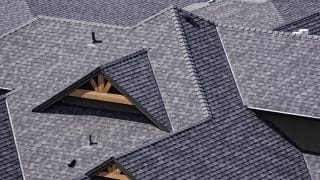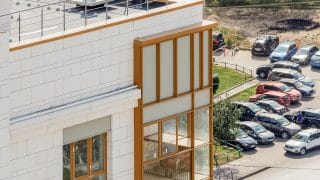House Framing Basics: Types, Terms, and Components
Jul 16, 2020

Light frame construction (known simply as “framing” in residential construction) is the technique of creating a structure based on vertical components, known as studs, which provide a stable frame for interior and exterior wall coverings. Horizontal elements, called joists, run the length of the floor, or between walls or beams. The joists support ceilings and floors.
Today, platform framing—in which each story is framed on top of the previous one—is the method of choice among most builders. Using one floor as the platform for the construction of the next floor creates a stable work surface. It also allows builders to use widely-available pieces of dimensioned lumber, versus the longer or more natural cuts of wood used in older methods.
Framing: a quick history lesson
Timber framing
Timber framing, which involves fitting together large posts and beams and connecting them with wooden pegs, was popular in the 18th and 19th centuries. In timber framing, builders work with natural logs and trees, rather than lumber pre-cut to common dimensions (like 2x4s). This framing method fell out of fashion because timbers were hand-hewn, and the advent of machine-sawn lumber allowed builders to construct homes more quickly with standard-sized (dimensional) lumber.
Balloon framing
In the 1830s, balloon framing became popular. This method involves using long, vertical 2x4s as studs, which extend from the sill on top of the foundation up to the roof, and which are secured by nails, rather than pegs. In balloon framing, a single stud could run up to 30 feet. The problem with using uninterrupted studs is the fire hazard: without breaks in the studs, a fire that starts low in the house can quickly shoot up to the top, razing the structure to the ground.
Platform framing
The most common framing technique in modern residential construction is platform framing, in which each story is framed on top of the previous one.
Builders will frame in one-story platforms of typically eight- or nine-foot-high stud walls resting on a subfloor—the platform. Each story is then framed on top of the next, and the roof rests on top of the construction. This method can be used for one- or two-story houses, and has become the standard among contemporary homebuilders because:
- Platform framing uses shorter pieces of lumber than previous techniques, like balloon framing, which is an advantage because longer studs are more difficult to obtain and more expensive.
- The breaks in the studs from level to level create natural firebreaks.
- Since builders erect the next floor right on a platform, they are building on a solid work surface—a safer environment, with high structural integrity.
Framing is one of the myriad aspects of construction that are captured in a set of blueprints. Learn everything you need to know about reading blueprints in MT Copeland’s online class, taught by professional builder and craftsman Jordan Smith.
Components of framing
Here are common framing elements you will use in each part of the house:
Light frame construction (known simply as “framing” in residential construction) is the technique of creating a structure based on vertical components, known as studs, which provide a stable frame for interior and exterior wall coverings. Horizontal elements, called joists, run the length of the floor, or between walls or beams. The joists support ceilings and floors.
Today, platform framing—in which each story is framed on top of the previous one—is the method of choice among most builders. Using one floor as the platform for the construction of the next floor creates a stable work surface. It also allows builders to use widely-available pieces of dimensioned lumber, versus the longer or more natural cuts of wood used in older methods.
Framing: a quick history lesson
Timber framing
Timber framing, which involves fitting together large posts and beams and connecting them with wooden pegs, was popular in the 18th and 19th centuries. In timber framing, builders work with natural logs and trees, rather than lumber pre-cut to common dimensions (like 2x4s). This framing method fell out of fashion because timbers were hand-hewn, and the advent of machine-sawn lumber allowed builders to construct homes more quickly with standard-sized (dimensional) lumber.
Balloon framing
In the 1830s, balloon framing became popular. This method involves using long, vertical 2x4s as studs, which extend from the sill on top of the foundation up to the roof, and which are secured by nails, rather than pegs. In balloon framing, a single stud could run up to 30 feet. The problem with using uninterrupted studs is the fire hazard: without breaks in the studs, a fire that starts low in the house can quickly shoot up to the top, razing the structure to the ground.
Platform framing
The most common framing technique in modern residential construction is platform framing, in which each story is framed on top of the previous one.
Builders will frame in one-story platforms of typically eight- or nine-foot-high stud walls resting on a subfloor—the platform. Each story is then framed on top of the next, and the roof rests on top of the construction. This method can be used for one- or two-story houses, and has become the standard among contemporary homebuilders because:
- Platform framing uses shorter pieces of lumber than previous techniques, like balloon framing, which is an advantage because longer studs are more difficult to obtain and more expensive.
- The breaks in the studs from level to level create natural firebreaks.
- Since builders erect the next floor right on a platform, they are building on a solid work surface—a safer environment, with high structural integrity.
Framing is one of the myriad aspects of construction that are captured in a set of blueprints. Learn everything you need to know about reading blueprints in MT Copeland’s online class, taught by professional builder and craftsman Jordan Smith.
Components of framing
Here are common framing elements you will use in each part of the house:
Floor
- Joists: These are horizontal framing components that run the length of the floor. They make up the support for the floor of the home and the platform that the wall panels will attach to. Floor joists are covered with subflooring (usually made of plywood).
- Truss: A floor truss consists of 2×4 or 2×3 lumber connected with metal plates. There are a number of configurations a truss can take, but it essentially forms a stable “web” to support the floor and resists bouncing.
- Sheathing: Floor sheathing, commonly known as the sub-floor, is a structural panel that is fastened to the floor structure. It carries the loads from above to the floor joists below.
Walls
Interior walls fall into two categories: load bearing and non-load bearing. A load-bearing wall supports a load from above, such as another floor or a roof. A non-load bearing, or a partition wall, is built separately from the main load bearing structure and can be an exterior or an interior wall. It functions as a divider but supports no weight. A third kind of wall—a shear wall, often used in multi-story buildings—is not built to bear a vertical load. Rather, shear walls are meant to resist lateral forces, such as wind and earthquakes. They are typically braced wooden walls with shear panels, reinforced concrete or masonry, or steel plates.
- Sill: This piece of lumber anchors the house to the foundation. The first-floor frame is built on top of the sill plates and consists of joists, which span the foundation walls.
- Top and bottom plates: The top plate is the piece of timber that runs along the top of the wall frame and supports the roof and ceiling. The bottom plate is the piece of timber that sits on the floor and forms the bottom of the wall.
- Studs: These are framing components that run between the top and bottom plate. They are usually spaced 16 or 24 inches apart and are the most common elements of the wall panel.
- Sheathing: Exterior wall sheathing strengthens the walls by tying the studs together. Builders commonly use wall panels such as gypsum, reinforced cement board, or plywood. You’ll first secure the sheathing to the frame, then cut holes for the windows and doors door openings. Exterior materials like siding are affixed to the sheathing.
- Doors and windows: There are several essential elements in door and window framing, such as the header: the horizontal structural element that bridges two vertical pillars and allows the installation of doors and windows without weakening the walls. The vertical pillars they rest on, normally 2x4s or 2x6s, are called king studs and trimmers (or jack studs). Together, they create a unit that transfers weight from above and around the door and window openings down to the floor and foundation.
Ceiling
- Joists: Ceiling joists are horizontal elements that span the ceiling and transfer the load of the roof to the studs. There is no set standard size, but the most commonly used lumber for joists today is 2×6. They are commonly spaced from 16 to 24 inches apart.
Roof
- Rafters: These structural components run from the ridge or the roof to the wall plate of the external wall, side by side, and support the roof sheathing. The building method that usually uses rafter roof construction is known as “stick framing.” Rafters are good for those who want a vaulted ceiling or extra room in the attic to convert into a room.
- Trusses: A truss is a wooden structure that is prefabricated in a kind of web shape of beams that extend to the top of the truss and a beam that runs horizontally. The shape is designed to distribute the weight of a roof over a broad area. Trusses can be installed quickly and have the advantage of using shorter, less expensive lengths of wood. However, they segment open attic space, so won’t work for those who might want to convert an attic later.
- Decking: The roof decking is the section of the roof assembly which sits on top of the rafters or trusses and provides the structure or “deck” for the weatherproofing and roofing layers. In residential construction, decking is generally made of plywood or oriented strand board.
The elements of framing can seem complex, but by learning them and their essential value in constructing a solid frame, you’ll learn one of the most important steps of home building. Not only does a frame give the home a structure and shape, it is integral to every aspect of the construction that comes after it, from interior and exterior finishes, to laying in mechanical, electrical, and plumbing plans.
MT Copeland offers video-based online classes that give you a foundation in construction fundamentals with real-world applications, like how house framing works. Classes include professionally produced videos taught by practicing craftspeople, and supplementary downloads like quizzes, blueprints, and other materials to help you master the skills.







